Guest post by Rebecca Sparke
Rebecca is a Courtauld Institute of Art graduate and she is currently interning at ‘La Maison des Mémoires’ in Carcassonne. Thank you Becca for writing this fascinating post!
Thank you Sarah
I am excited, although a little nervous, to have been invited by my beautiful and intelligent friend Sarah to write as a ‘guest blogger’ here on Oh So Arty.com. Despite using her third language, Sarah manages to write with far more eloquence and much more succinctly in English than I have ever been able to do. This ability to converse and write in numerable languages is something I am increasingly in awe of after my recent move to France.
Since starting her blog Sarah’s entries have provoked me to think more carefully about what it is that I am seeing and experiencing everyday, and it has certainly enhanced if not re-instated my love of art. Sarah has been a true friend for the past four years. I admire her passion and dedication to the arts as well as good food, the people around her and indeed life. All these qualities are portrayed in her many entries here on ‘Oh so arty.com’.
Thank you Sarah for your continuing support and friendship despite the great distance apart at which we now live!
How and Why I am in Carcassonne
Thanks to the UN’s Leonardo scheme, I am now happily living and working in beautiful Carcassonne. It is a world famous town situated in the Langudoc-Roussillion region of south-eastern France.
Tourists from all around the globe flock to Carcassonne each year, principally to see the towns famous UNESCO world heritage site La Cité. As high season approaches it is rather stressful having to battle through the droves of holidaymakers fresh off the daily Ryan Air flights. However, despite these stresses La Cité never seems to loose its appeal. Its magnificent beauty elevated against the backdrop of the Southern French sky is particularly stunning in the early dawn or late evening. This subtle lighting somewhat ironically, due to the fortresses’ bloody and violent past, portrays a fairy-tale image.

‘La Cité’, Carcassonne – finally the rain stops just before dusk, May 2009(R.K. Sparke)
However, despite its magnificence, my entry will not focus on La Cité. Instead I’d like to introduce you to La Maison des Mémoires, its fascinating history, fantastic exhibition space and the exhibition of contemporary artist Joan Jordà’s work.
What is La Maison des Mémoires?
La Maison des Mémoires is a four story building on the Rue de Verdun in Carcassonne’s new town dating from the late 16th and early 17th century. It contains the Centre d’Études Cathar (The Cathar Studies Centre) the association with whom I am currently ‘la petite stagiaire anglaise’ (The little English Intern), and Le Centre Joë Bousquet et son Temps which is a memorial museum on Joë Bousquet and a superb exhibition space.
La Maison des Mèmoires – 53 Rue de Verdun, Carcassonne (R.K.Sparke)
Le Centre Joë Bousquet et Son Temps
The centre is an exhibition space, which was set up in memoriam of the French poet and writer Joë Bousquet by his family some twenty years after his death in 1950. The organisation’s aim is to promote culture and to provide free exhibitions of a historical, artistic or literary nature to the public. The temporary exhibition changes every two months, so in any one year there can be a great variety of shows. It is a superb space and setting for any of the types of exhibition listed above, but in my opinion particularly art.
Despite its excellence, since working in the same building as this centre, I have noticed that despite its exciting exhibition programme and the quality of its shows Le Centre Joë Bousquet et Son Temps is somewhat under visited and publicised. It certainly doesn’t receive as many visitors as a town who welcomes tens of thousands of tourists each year should do. However, after learning a little about Joë Bousquet’s life and ideas, it seems rather fitting that the centre and its cultural program has to be sought out. That only those who are in search of the arts and truly understand what the arts can offer are lucky enough to experience what is on show. However, I am by no means an expert on Bousquet nor do I have detailed visitor statistics. This is simply an unfounded observation!
Joë Bousquet
Painting of Joë Bousquet by André Blondel
After receiving a detailed tour on the life and work of Joë Bousquet by the museum’s excellent curator ‘Claude’ I was left moved but also struck with a refreshed belief in the arts. Recently I am being constantly persuaded to turn towards more ‘practical’ and ‘rational’ interests. However, the story of Joë Bousquet argues against such advice and highlighted for me the power and importance of the arts. For Joë Bousquet art and literature was so powerful that they became his ‘raison d’être’.
In 1916 at the mere age of nineteen Joë Bousquet enlisted in the army. Whilst serving in WW1 Bousquet was tragically severely wounded. He was left paralysed from the waist down loosing the use of both legs. The severity of this accident need not be emphasised, but see below the dramatic differences between the appearance of the man in the first image ‘a bright young thing’ before the war and that only a few years after. (Something that Claude brought to my attention).
‘La Vie immobile’ (by Bousquet): ‘Pour moi le temps n’est pas fait des jours mais de coincidences’In 1939 Joë Bousquet moved to apartment 41 Rue de Verdun, which is now Le Centre Joë Bousquet et Son Temps. His family lived in suites of rooms either side of his own. Once settled here in the apartment, and more specifically his room, Joë Bousquet was never to leave until his death in 1950.
He lived and worked continuously for eleven years in the room pictured below. The bedroom was left untouched after his death and is on display to see today exactly as it was then.
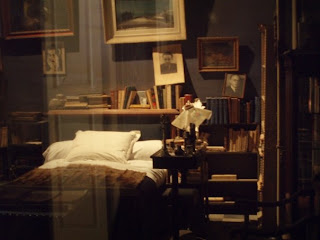
Joë Bousquet’s room which can now be viewed behind glass in the centre.
In his diary in September 1949 Bousquet writes: ‘Chaque jour est l’heure de ma mort’.
The room was his world – made up of books and art. A painting by Max Ernst is prominently on display. This is a testament to his involvement with the Surrealist movement and his friendship with Max Ernst. Today there are only a handful of paintings on the walls. In his life time canvases covered every bit of wall space, changing on a regular basis (often so he could write reviews on artists’ work). He shut the world out and created his own, allowing only the light from his lamp to enter. The window, through which we now view his room was even blacked over at Joë’s request and replaced with art. Paintings were all he wanted to witness of the outside world.
Bousquet was deeply involved and influential in the Surrealist movement. He had many close friends and work associates within this movement. For example, to name just a few J. Poulhon, G. Galluard, L. Aragon, Delaunay, Magritte, P. Eluard, H. Micheaux, and M. Earnst. Joë Bousquet attracted numerous friends and colleagues, most of which shared his intellectual love of art and literature. He also invited or accepted students and young culture lovers to meet with him from time to time.
At the moment I am living in a small apartment in the house Jean and Janette Pidoux. Jean Pidoux is an eighty year old gentleman (and an excellent artist) who had the opportunity to talk and meet Joë Bousquet here in Carcassonne when he was in his early 20’s. Jean Pidoux tell’s me that he wrote to Bousquet requesting a meeting as he had enjoyed his literature and happened to be passing through Carcassonne for a few days (at this time M. Pidoux was living and working elsewhere). However, the picture Jean creates of Bousquet through his descriptions is rather miserable. ‘He was irritable and in pain. He was a genius in torment and sat smoking opium to subside the pain.’ (This is as best as I can translate his sentiments (as much as I understood them).
Works by Jean Pidoux an artist in his own right.
However, perhaps it is important to remember that this was a man at the end of his life after years of suffering. In a way, being aware of Bousquet’s suffering helps us to further appreciate his dedication to literature and the arts. His writing, surrealist input, the friendship he showed to many, as well as his bravery and perseverance are inspirational. Joë Bousquet risked his life for his country in WW1. In WW2 he risked being caught when hiding Jewish and banned publications by the Nazi’s in his room here in Carcassonne. He lived and gave his life to the arts and to the promotion of the creations and mastery of his friends. Despite his retreat into an insular world he is to be admired. If there is ever a need’s to justify the arts and the power that they harbour then Joë Bouquet’s life is that. He is a testament to how necessary the arts are to society and that for some (rightly or wrongly) they can be enough to fill someone’s entire life.
Joë Bousque is well known for his early work and writings in ‘Les Cahiers du sud’ pictured above.
The exhibition space at the centre
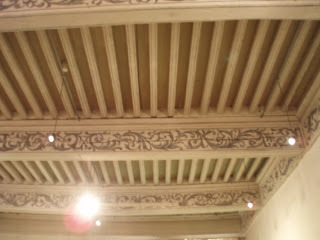 When renovating the Bousquet apartments to create the exhibition space these original 16th century decorations and beams were found that the family never knew existed. They are now on display in the gallery.
When renovating the Bousquet apartments to create the exhibition space these original 16th century decorations and beams were found that the family never knew existed. They are now on display in the gallery.
Recent Exhibitions
Up until yesterday, Joan Jordà’s work was on display. This exhibition opened 20th March and closed on the 30th May 2009.
This artists work is somewhat ‘primitive’ in its style, and its essence is evidently an aggressive one. The artist seems particularly interested in the aggression of the human form.
In the short guide received on entering the exhibition to accompany the viewer throughout their visit, there is an extract written by the artist. It is written in the form of a poem, and its content is aggressive and damning. Describing the harsh reality of life as an artist and the struggles that it entails.I attended a ‘rendez-vous’ with the artist and his friends last Saturday (an event which was open to all members of the public). The artist spoke briefly about his work. At this conference, he refused to discuss the meaning of his art. He argued that it is for the viewer to find. Yet he did suggest that there a reference to war, human violence and aggression in much of his work. However, the aggression that Joan Jordà evidently contains and expresses through his art is certainly hidden deep within him. This small and somewhat frail looking man, who speaks softly and kindly, appeared rather shy at being the centre of a large conference. This was rather surprising to me as it was so unlike the artist I had imagined after viewing the exhibition.
There is some art in the exhibition, which is less aggressive, and concentrates rather on the human form in its natural and free ‘primitive’ state as well as environment. For example the image that is depicted below and entitled: A Series: ‘Les Egorgues’
I would certainly encourage anyone who is in Carcassonne to visit this gem of an institution here at ‘La Maison des Mémoires’. It is easily accessible and just a few 100 meters away from the towns central tourist office and La Musée des Beaux-Arts. Furthermore, after visiting the current exhibition why not climb the stairs to the library and Médiatheque belonging to the Cathar Study Centre and pay me (or if by this time I have finished my work here) Véronique a visit. Perhaps discover a little about Cathar history and the surrounding area before continuing your travels in the ‘Pays du Cathar’.
Le Musée des Beaux-Arts, Carcassonne
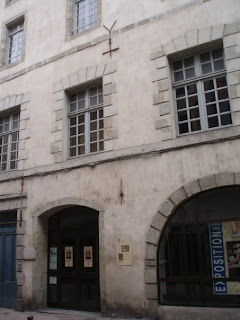





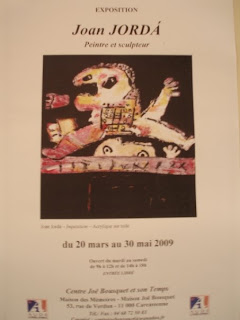


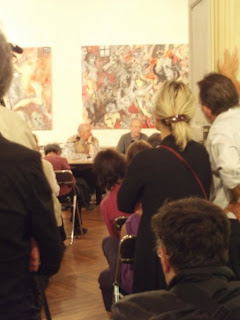



4 Responses to “Guest post by Rebecca Sparke”
Chère Rebecca,
c’est vraiment intéressant de te lire et de plus tu m’as donné envie de lire Joël Bousquet (j’adore les citations que tu as choisies) que je ne connais pas.
Amitiés
Wow, guest blogger – what a great Idea! keep up the good work sarah and congrats on a well written post rebecca!
This is a beautiful post! Thank you
This is an amazing post ! And an amazing blog ! Well done to both of you ! Really Interesting !
Comments are closed.